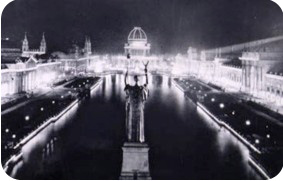The end of night
 Monday, November 22, 2010 at 10:18PM
Monday, November 22, 2010 at 10:18PM  Columbian Exposition in Chicago, 1893 - the dawn of the age of light. Image: PBS.orgOver 60 million Americans have problems sleeping. While insomnia has many causes, one is the use of electric lighting. Our circadian rhythms developed from the 24-hour rotation of the Earth. At the end of the day, the slowly fading sunlight allowed the brains of our hominid ancestors to prepare for sleep. Around 1 million years ago, hominids began to use fire and congregate around campfires for warmth and safety. Socialization increased. Eventually cooking developed and led to further brain evolution.
Columbian Exposition in Chicago, 1893 - the dawn of the age of light. Image: PBS.orgOver 60 million Americans have problems sleeping. While insomnia has many causes, one is the use of electric lighting. Our circadian rhythms developed from the 24-hour rotation of the Earth. At the end of the day, the slowly fading sunlight allowed the brains of our hominid ancestors to prepare for sleep. Around 1 million years ago, hominids began to use fire and congregate around campfires for warmth and safety. Socialization increased. Eventually cooking developed and led to further brain evolution.
The first lamps, made from moss or other plant material and animal fat placed in a natural stone recesses, are tens of thousands of years old. Portable lamps fueled by animal fat, and later oil, were carried by Cro-Magnon into the deep recesses of the Lascaux and Altamira caves where they painted remarkable images of ice age fauna 13,000-18,000 years ago.
First used around 400 AD, candles were an important form of lighting for 1,500 years until the development of gas lighting at the end of the eighteenth century. As noted in A History of Light and Lighting, candles could be linked together to create a spectacle:
In 1761, at the coronation of George III, groups of 3000 candles were connected together with threads of gun cotton, and lit in half a minute. Those clustered below were showered with hot wax and burning thread.
Campfires, oil lamps, candles and gas lamps cast a dim light and nighttime activity remained limited. However, at some point, night was effectively overcome. An important landmark was Edison’s invention of the long-lasting incandescent lamp in 1879. The first lasting 13.5 hours.
My pick for the year in which we overcame night is 1893, the year that Nikoli Tesla lit up the night at Columbian Exposition in Chicago. Following a prolonged rivalry with Edison regarding the most effective current for delivering electricity, Nikoli used long-lasting bulbs (by Westinghouse) and alternating current to create "the most spectacular display the world had ever seen". The dawn of electric lighting was the Internet of its age: it changed everything. Using electricity, daytime could be all day long. We could work day or night, or both.
Where does this take us? Well, back to the sleep problem. You are heading to bed and the light in the bedroom is likely bright. When ready for sleep, you turn off the current to the incandescent bulb(s). Imagine what your brain must be whispering: “What, you expect me to release this stuff immediately? Can you at least warn me?”
Normally, as light fades, melatonin is released (dis-inhibited) and, working in concert with a build-up of adenosine, brings on sleep. While some fall into a deep sleep quickly even with the lights on, many of us need a slow transition from light to dark to be adequately prepared for restful sleep. In the modern world, electrons heat the bulb's filament causing it to glow and shower photons on our retinas (even through closed lids) and keeps us awake. We have to be a little wiser to get the sleep we need.


Reader Comments